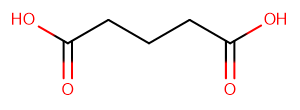
Glutaric acid
CAS No. 110-94-1
Glutaric acid( —— )
Catalog No. M19551 CAS No. 110-94-1
Glutaric acid is a simple five-carbon linear dicarboxylic acid. Glutaric acid is naturally produced in the body during the metabolism of some amino acids including lysine and tryptophan. Glutaric acid may cause irritation to the skin and eyes. When present in sufficiently high levels glutaric acid can act as an acidogen and a metabotoxin.
Purity : >98% (HPLC)
 COA
COA
 Datasheet
Datasheet
 HNMR
HNMR
 HPLC
HPLC
 MSDS
MSDS
 Handing Instructions
Handing Instructions
| Size | Price / USD | Stock | Quantity |
| 100MG | 41 | In Stock |


|
| 200MG | Get Quote | In Stock |


|
| 500MG | Get Quote | In Stock |


|
| 1G | Get Quote | In Stock |


|
Biological Information
-
Product NameGlutaric acid
-
NoteResearch use only, not for human use.
-
Brief DescriptionGlutaric acid is a simple five-carbon linear dicarboxylic acid. Glutaric acid is naturally produced in the body during the metabolism of some amino acids including lysine and tryptophan. Glutaric acid may cause irritation to the skin and eyes. When present in sufficiently high levels glutaric acid can act as an acidogen and a metabotoxin.
-
DescriptionGlutaric acid is a simple five-carbon linear dicarboxylic acid. Glutaric acid is naturally produced in the body during the metabolism of some amino acids including lysine and tryptophan. Glutaric acid may cause irritation to the skin and eyes. When present in sufficiently high levels glutaric acid can act as an acidogen and a metabotoxin. An acidogen is an acidic compound that induces acidosis which has multiple adverse effects on many organ systems. A metabotoxin is an endogenously produced metabolite that causes adverse health effects at chronically high levels. Chronically high levels of glutaric acid are associated with at least three inborn errors of metabolism including glutaric aciduria type I malonyl-CoA decarboxylase deficiency and glutaric aciduria type III. Glutaric aciduria type I (glutaric acidemia type I glutaryl-CoA dehydrogenase deficiency GA1 or GAT1) is an inherited disorder in which the body is unable to completely break down the amino acids lysine hydroxylysine and tryptophan due to a deficiency of mitochondrial glutaryl-CoA dehydrogenase (EC 1.3.99.7 GCDH). Excessive levels of their intermediate breakdown products (e.g. glutaric acid glutaryl-CoA 3-hydroxyglutaric acid glutaconic acid) can accumulate and cause damage to the brain (and also other organs). Babies with glutaric acidemia type I are often born with unusually large heads (macrocephaly). Macrocephaly is amongst the earliest signs of GA1. GA1 also causes secondary carnitine deficiency because glutaric acid like other organic acids is detoxified by carnitine. Abnormally high levels of organic acids in the blood (organic acidemia) urine (organic aciduria) the brain and other tissues lead to general metabolic acidosis.
-
In VitroGlutaric acid (GA) at concentrations of 1 and 2 mM is able to reduce TRAP measurement by up to 28% in a dose-dependent manner (β=0.77; P<0.001). Furthermore, a significantly inverse correlation is also verified between chemiluminescence and TRAP (β=0.81; P<0.001). Glutaric acid does not alter the activities of Cat and SOD, but strongly inhibits (up to 46%) the activity of GPx even at the lower concentration used (0.5 mM). It is observed that the metabolite inhibits this activity in a dose-dependent manner at concentrations as low as 0.05 mM.
-
In Vivo——
-
Synonyms——
-
PathwayProteasome/Ubiquitin
-
TargetEndogenous Metabolite
-
RecptorEndogenous Metabolite
-
Research Area——
-
Indication——
Chemical Information
-
CAS Number110-94-1
-
Formula Weight132.11
-
Molecular FormulaC5H8O4
-
Purity>98% (HPLC)
-
SolubilityDMSO: 10 mM;Water:5 mg/mL;Ethanol: Soluble
-
SMILESOC(=O)CCCC(O)=O
-
Chemical Name——
Shipping & Storage Information
-
Storage(-20℃)
-
ShippingWith Ice Pack
-
Stability≥ 2 years
Reference



-
3-Hydroxybutyric aci...
3-Hydroxybutyric acid (or beta-hydroxybutyrate) is a ketone body. Like the other ketone bodies (acetoacetate and acetone) levels of 3-hydroxybutyrate in blood and urine are raised in ketosis. In humans 3-hydroxybutyrate is synthesized in the liver from acetyl-CoA and can be used as an energy source by the brain when blood glucose is low.
-
Phenylacetic acid
Phenyl acetate (or phenylacetate) is a carboxylic acid ester that has been found in the biofluids of patients with nephritis and/or hepatitis as well as patients with phenylketonuria (PKU) an inborn error of metabolism. Excess phenylalanine in the body can be disposed of through a transamination process leading to the production of phenylpyruvate.
-
26-Dihydroxybenzoic ...
26-Dihydroxybenzoic acid is a secondary metabolite of salicylic acid which has been hydrolyzed by liver enzymes during phase I metabolism.



 Cart
Cart
 sales@molnova.com
sales@molnova.com


